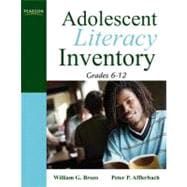
Dr. William G. Brozo was a co-investigator on a Carnegie Grant team that compiled an important report on best practice in adolescent literacy (Principled Practices for Adolescent Literacy: A Framework for Instruction and Policy, Erlbaum). He is a member of the Adolescent Literacy Committee, and member of the PISA/PIRLS Task Force responsible for analyzing international reading assessments. His other Pearson Education books include Content Literacy for Today’s Adolescents: Honoring Diversity and Building Competence, 50 Content Area Strategies for Adolescent Literacy, and Supporting Content Area Literacy with Technology: Meeting the Needs of Diverse Learners. He has taught reading and language arts in junior and senior high school in the Carolinas and is currently Professor of Literacy in the Graduate School of Education at George Mason University.
Dr. Peter Afflerbach is a Professor in the Reading Center, Department of Curriculum and Instruction at the University of Maryland at College Park. His most recent book is Understanding and Using Reading Assessment, K-12 (International Reading Association). His research interests include literacy assessment, the alignment of reading assessment with standards for reading and the strategies that readers use to understand text. His research has been published in numerous theoretical and practical journals. He is a past editor of the Reading Assessment column in The Reading Teacher, and he serves on the Editorial Advisory Boards of The Reading Teacher, Reading Research Quarterly, and Journal of Educational Psychology. He is a co-editor of the Handbook of Reading Research. Currently, he serves on the Reading Committee of the National Assessment of Educational Progress (NAEP), the Reading Framework 2009 Committee of the National Assessment of Educational Progress (NAEP) and the Reading Committee of the National Adult Literacy Survey (NALS).
Section 1
Introduction to the Adolescent Literacy Inventory and the Adolescent Reader
--The Adolescent Literacy Inventory and the Construct of Reading
--How Does Such an Assessment Enterprise Work?
--The Adolescent Literacy Inventory and the Construct of Assessment
--Ecological Validity
--Consequences of Assessment
--Demands on Our Students in School and in the World Beyond School
--Formative Uses of the Adolescent Literacy Inventory
--Characteristics of Adolescent Readers and Writers
--Theoretical and Research Dimensions of Adolescent Literacy
--Cognitive Strategies and Reading
--Advances in Our Understanding and Use of Effective Reading Assessment
--The Role of Formative Literacy Assessment in Improving Adolescents’ Literacy
--References
Section 2
A Description of the Components of the Adolescent Literacy Inventory and Administration Procedures
--Decision Tree
--Development and Description of the Features of the ALI
--The Maze Placement Passages: Development and Directions
--Administering Maze Passages
--Reading Passages: Development and Directions
--Pre-Reading Administration Options
--Text impression and Venn diagram
--Vocabulary self-awareness
--Reading Comprehension Questions
-Passage Reading Options
--Procedures For Assessing A Student’s Ability to Read Content Text
--Procedures For Assessing A Student’s Reading Skills
--Oral Reading
--Words Correct Per Minute (WCPM)
--Steps in Conducting a WCPM Assessment
--Miscues and Miscue Analysis
Steps In Conducting An Assessment Of Oral Reading
Miscues
--Marking and Analyzing Oral Reading Miscues
--Content Specific Reading Abilities and Skills
--Interactive Assessment
--Steps in Conducting an Interactive Assessment
--References
Section 3
The Adolescent Literacy Inventory: Next Steps
--Maximizing the Results of the Adolescent Literacy Inventory
--Patterns of Reading Challenge and Next Steps
--1. The reader who lacks prior knowledge for the text
--Actual behaviors
--Next steps
-2. The reader who needs to better understand that reading is done to construct meaning from text and not to demonstrate perfect oral reading
--Actual behaviors
--Next steps
--3. The student who focuses on word-by-word reading but does not understand
--Actual behaviors
--Next steps
-4. The student who has individual skills and strategies but isn’t able to coordinate them to achieve success in reading
--Actual behaviors
--Next steps
--5. The reader who is experiencing word-level processing bottlenecks
--Actual behaviors
-Next steps
--A Final Note on Motivation and Reader Self-Esteem
--Actual behaviors
--Next steps
Section 4
Math: Teacher and Student Protocols
Section 5
Language Arts: Teacher and Student Protocols
Section 6
Science: Teacher and Student Protocols
Section 7
Social Studies: Teacher and Student Protocols
The New copy of this book will include any supplemental materials advertised. Please check the title of the book to determine if it should include any access cards, study guides, lab manuals, CDs, etc.
The Used, Rental and eBook copies of this book are not guaranteed to include any supplemental materials. Typically, only the book itself is included. This is true even if the title states it includes any access cards, study guides, lab manuals, CDs, etc.